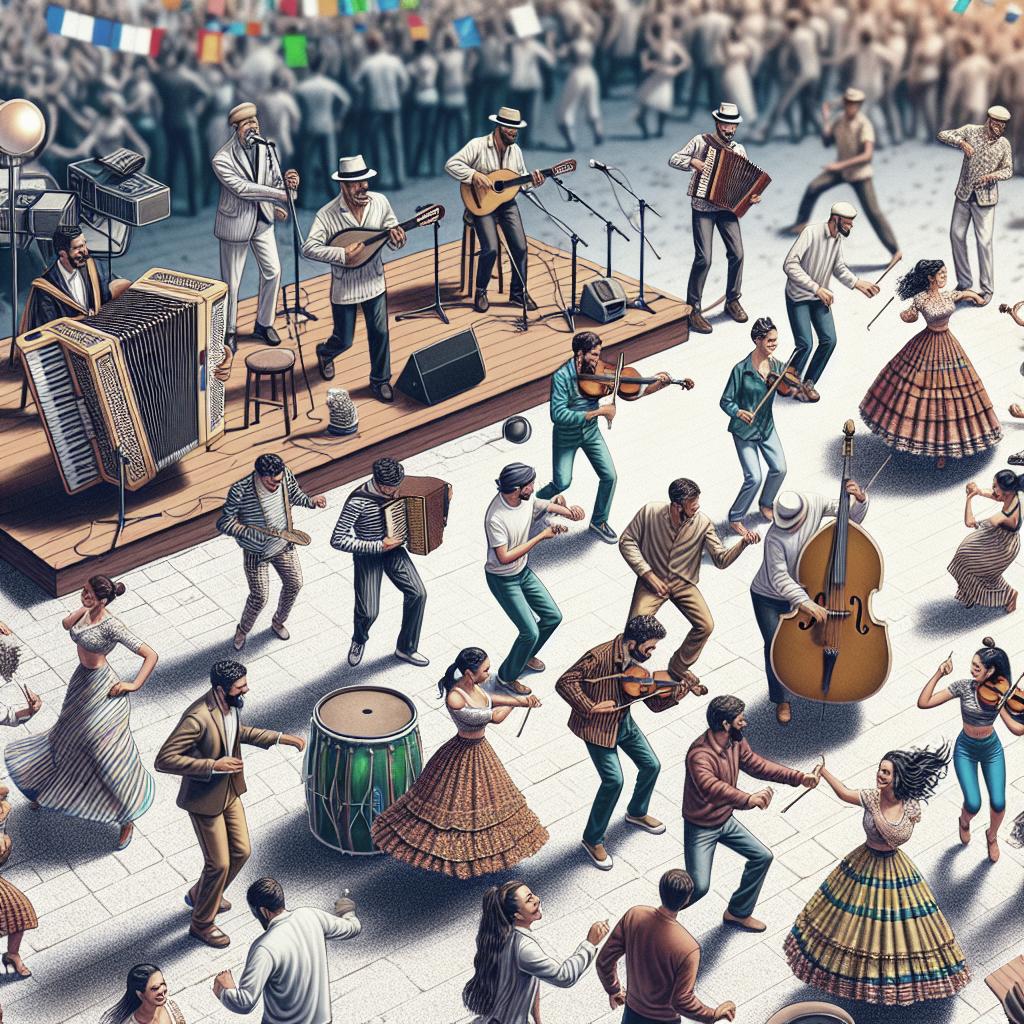“`html
The Vibrant World of Cumbia
Cumbia, a genre with deep roots in Latin American culture, is more than just music; it’s a celebration of rhythm, tradition, and diversity. Originating from Colombia’s Caribbean coast, cumbia has transcended borders and evolved into numerous styles, each with its distinct flair and influence. In this exploration, we’ll delve into the heart of cumbia through the lens of influential artists and groups like Carmen Rivero, Los Gaiteros de San Jacinto, and Pedro Laza. We’ll also see how this genre is embraced globally, with contributions from iconic bands like Los Lobos and Los Pecos, and unexpected collaborations such as Macklemore & Ryan Lewis with Fito Olivares. Join us as we uncover the stories and sounds that make cumbia an undeniable musical phenomenon across Latin America and the world.
Taylor Swift: Speak Now (Taylor’s Version)
Although not directly linked to cumbia, Taylor Swift’s re-recording of her album “Speak Now” symbolizes a broader movement in the music industry, where artists reclaim their work and create new expressions of their past creations. Her dedication to revamping her past albums demonstrates an artistic journey that resonates with the constant evolution inherent in musical genres like cumbia.
Swift’s version draws parallels with how cumbia has metamorphosed through the years, adapting to societal changes while maintaining its core identity. This process of reinvention and preservation echoes throughout the musical histories we will discuss, illustrating how timeless tunes can be reshaped to remain relevant.
Cumbia: The Musical Backbone Of Latin America
Cumbia’s origins date back to the fusion of Indigenous Colombian, African, and Spanish influences, creating a dance and music style characterized by its distinctive, rhythmic beat. It serves as a cultural backbone, providing a musical narrative of Latin America’s rich and diverse history.
Over the decades, cumbia has branched out beyond Colombia, resonating throughout Latin America and beyond. Its adaptability is one of its greatest strengths, as it absorbs elements from regional styles, resulting in variations like Mexican cumbia, Argentine cumbia, and more. Each iteration retains the fundamental sound that unites listeners in a shared cultural experience defined by joy and community.
Carmen Rivero
Carmen Rivero, often hailed as the “Queen of Cumbia,” played a pivotal role in popularizing cumbia in Mexico. Her contributions in the mid-20th century saw her blend traditional cumbia with modern influences, creating a version that appealed to both nostalgic and contemporary audiences.
Rivero’s impact was profound, as she introduced the electric guitar to cumbia, a novel concept at the time. Her innovative approach not only broadened the genre’s appeal but also paved the way for future musicians to experiment with instrumentation and style while honoring cumbia’s roots.
Los Gaiteros de San Jacinto from Colombia
Hailing from Colombia, Los Gaiteros de San Jacinto embody the traditional essence of cumbia. This legendary group champions the preservation of traditional Colombian music through their powerful performances that showcase instruments like the gaita flute and indigenous drums, elements that are quintessential to cumbia’s early soundscape.
By maintaining these traditional elements, Los Gaiteros de San Jacinto preserve the cultural heritage of cumbia, making it accessible to new generations. Their music is more than entertainment; it’s a living archive of a genre that continues to influence the soundwaves of today.
Pedro Laza
Pedro Laza, a celebrated bandleader and composer from Colombia, is revered for his rich contributions to cumbia’s evolution. Active in the mid-20th century, Laza’s work with his band, Los Pelayeros, was central to popularizing cumbia both locally and abroad, introducing urban audiences to coastal rhythms.
His compositions like “Cumbia Cienaguera” remain iconic, capturing the quintessential sound of cumbia that elicits nostalgia and pride for many Colombians. Laza’s music continues to inspire countless artists, cementing his legacy as a cornerstone in the genre’s development.
Los Lobos
Los Lobos, an East Los Angeles band, are known for their rock and roll, but they’ve also embraced cumbia, showcasing how the genre can transcend cultural and musical boundaries. Their incorporation of cumbia into their broad repertoire highlights the genre’s versatility and widespread appeal.
This blend of rock, blues, and cumbia illustrates how genres can coexist and enrich each other, leading to innovative sounds that respect their original roots while offering fresh perspectives. Los Lobos’ contributions highlight cumbia’s adaptability and its ability to engage audiences far from its origins.
Los Pecos
Known predominantly in the Spanish-speaking world, Los Pecos brought a pop-infused touch to cumbia, infusing it with youthful energy and mainstream appeal. Their approach helped introduce cumbia to a broader audience, particularly among younger listeners eager for something both familiar and fresh.
By blending cumbia with pop sensibilities, Los Pecos played an essential role in modernizing the genre, making it more accessible to those previously unfamiliar with its traditional forms. Their work illustrates music’s potential to evolve and resonate across generation gaps.
Charles Mingus
While not directly associated with cumbia, Charles Mingus was an American jazz musician who embraced a multicultural approach to music, similar to the ethos found in cumbia. His experimental nature and ability to weave different musical traditions serve as an inspirational parallel to the evolutionary path of cumbia.
Mingus’s legacy of improvisation and fusion across genres mirrors the adaptability of cumbia in absorbing diverse influences while maintaining a distinctive core. His contributions remind us of the fluidity between musical worlds, a key theme in cumbia’s global journey.
Macklemore & Ryan Lewis feat. Fito Olivares
This unique collaboration between Macklemore & Ryan Lewis with Fito Olivares exemplifies cumbia’s broad appeal and its potential to merge with modern genres like hip-hop. Fito Olivares, a legendary cumbia artist, brought his expertise to this fusion, highlighting cumbia’s adaptability.
The track served as a bridge between distinct musical styles, showcasing cumbia’s infectious rhythm alongside contemporary beats and lyrical storytelling. This collaboration reflects cumbia’s enduring influence and its ability to blend with modern musical trends while staying true to its roots.
Yerba Brava
Yerba Brava, an Argentine band, represents the sub-genre of cumbia villera, known for its gritty, urban vibe and socially conscious lyrics. They bring a uniquely local touch to cumbia, addressing issues pertinent to their own cultural backdrop and resonating with urban audiences.
Their music speaks to the struggles and triumphs of everyday life, offering a voice to the marginalized and reflecting cumbia’s role as a music of the people. Through their thoughtful lyrics and energetic performances, Yerba Brava keeps cumbia relevant and poignant for Latin American youth.
Royal Highness
Royal Highness, while not a traditional cumbia group, brings an avant-garde twist to the genre, experimenting with its fusion into electronic and modern music landscapes. They demonstrate how cumbia can evolve and intersect with contemporary sounds while still maintaining its rhythmic roots.
By pushing the boundaries of what cumbia can be, Royal Highness expands its potential reach and relevance in today’s rapidly changing musical environment. Their work speaks to the perpetual rebirth of cumbia, as it adapts to new artistic expressions and technologies.
Summary of Main Points
| Subheading | Key Points |
|---|---|
| Taylor Swift: Speak Now (Taylor’s Version) | Re-recorded album; parallels with cumbia’s evolution. |
| Cumbia: The Musical Backbone Of Latin America | Origins in fusion of cultures; widespread adaptations. |
| Carmen Rivero | Queen of Cumbia; modernization of the genre in Mexico. |
| Los Gaiteros de San Jacinto from Colombia | Traditional sound; preservation of cultural heritage. |
| Pedro Laza | Iconic bandleader; popularization of cumbia in urban areas. |
| Los Lobos | Rock and roll with cumbia influences; cultural fusion. |
| Los Pecos | Pop influence; modernizing cumbia for younger audiences. |
| Charles Mingus | Jazz parallels; multicultural approach similar to cumbia. |
| Macklemore & Ryan Lewis feat. Fito Olivares | Fusion of hip-hop and cumbia; emphasizes adaptability. |
| Yerba Brava | Cumbia villera; urban and socially conscious themes. |
| Royal Highness | Experimental; merging cumbia with modern electronic sounds. |
“`


